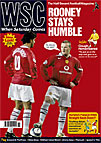 The MLS seemed intent on turning its back on millions of Hispanic potential fans but, as Mike Woitalla relates, there is now an LA offshoot of a top Mexican team
The MLS seemed intent on turning its back on millions of Hispanic potential fans but, as Mike Woitalla relates, there is now an LA offshoot of a top Mexican team
Walt Whitman once offered his opinion on the USA’s cultural mix: “The British and German, valuable as they are in the concrete, already threaten excess. Something outside them, and to counterbalance them, is seriously needed… To that composite American identity of the future, Spanish character will supply some of the most needed parts.” Walt said that in 1883, but it could be applied to the history of American soccer throughout its evolution. Not until 1996, when Major League Soccer launched, was America’s ever-increasing Hispanic population finally recognised as a key to success. MLS made signing Latin American stars a priority – to lure Hispanic fans and to create a skill-based style of play that would be more likely to entertain than the northern European game.
But after a promising start, the league’s commitment to Hispanic fans and Latin players waned. MLS squandered their invaluable presence on major Spanish-language television after 2001. They allowed their coaches, almost all European or of European descent, to sign ageing players from their home continent with no appeal whatsoever to Latino fans. For instance, New England manager Steve Nicol, the Scot of Liverpool fame, brought in 33-year-old Steve Howey from Bolton. Steve Whoey? In Dallas, where the population is 35 per cent Hispanic, manager Colin Clarke, while purging Latinos from the team, welcomed his Northern Ireland countryman Steve Morrow, once of Arsenal, and high-fouling Finland midfielder Simo Valakari – anybody remember his four seasons at Derby? – then watched attendances dip to a league-low 9,000. In 1996, with Mexico great Hugo Sanchez, Dallas averaged 16,000 fans and outdrew the city’s basketball and hockey teams.
XIn cities such as San Jose, team operators turned their back on Hispanic fans to concentrate on a futile attempt to lure the white suburban youth soccer crowd to its stadiums. What were the MLS investors, who include some of the most acclaimed businessmen in the country, thinking?
In 2003, the Hispanic population had risen to 39 million to become the United States’ largest minority: 13 per cent of the populace. Hispanics are now coveted by politicians and marketeers. George W Bush’s campaign, which has given up on the black vote, says it needs 38 to 40 per cent of the Hispanic vote to win
in November. Advertisers spend $3,000 million (£1660m) a year marketing their products to Hispanics in a nation where salsa outsells ketchup by more than $40m annually. The top-rated radio stations in major cities are Spanish-language. But MLS has failed to capture the interest of Mexican-Americans, who comprise 60 per cent of the US Hispanic population.
That, however, is about to change dramatically, thanks to Chivas USA, who join the league in 2005 as an MLS version of Chivas of Guadalajara, Mexico’s most popular team, who have a huge following north of the border. Chivas USA will share the Galaxy’s shiny new stadium in Los Angeles County, where 45 per cent of the 9.8 million population is of Mexican heritage.
Chivas’s popularity in Mexico stems from them being the only club that uses only Mexican players. For Mexican-Americans, the red-and-white Chivas jerseys are a symbol of Mexican pride. “It’s hard for you, in a lot of ways, to come here and leave everything behind,” says Ramon Beristain, a 42-year-old who emigrated from Mexico City in 1987 but supports the Guadalajara club. “You lose so much and you want to hold on to something.” So Beristain, like millions of Mexican-Americans, has followed Chivas on US Spanish-language television and gone to their games when they tour the USA. He has previously shunned MLS, but is now interested: “I think most Mexican-Americans are going to follow Chivas USA.”
MLS rules allow a team three foreigners of any age and a handful of “transitional internationals”, who must be under age 25. That means Chivas USA will field up to nine Mexicans. They plan to fill out the roster with Mexican-Americans and other US-born Latinos.
Jorge Vergara, whose direct-sale health supplements company OmniLife is grossing more than $1,000m a year, bought Chivas Guadalajara in 2002 for $100m. Vergara, who also owns Costa Rican champions Saprissa and the movie company that produced Oscar nominee Y Tu Mama Tambien, spent $25m on Chivas USA start-up costs.
Along with Chivas USA, a Utah franchise will join the league in 2005, upping the membership to 12 teams. When the Utah entry into the league was announced, one publication announced professional soccer was arriving in the middle of “white America”. It quickly received a call of protest from a Salt Lake City official who boasted that Utah’s population is now nine per cent Hispanic. Walt Whitman would have been impressed.
From WSC 213 November 2004. What was happening this month